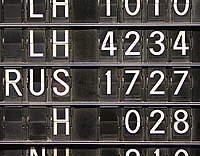Flight number: Difference between revisions
m made the introduction of the term "flight code" bold |
No edit summary |
||
| Line 10: | Line 10: | ||
Flight numbers are often taken out of use after a crash or a serious incident. For example, following the crash of [[Alaska Airlines Flight 261]], the airline changed the flight number for subsequent flights following the same route to 295. Also, [[American Airlines Flight 11]], which regularly flew from [[Logan International Airport]] in East Boston, Massachusetts, to [[Los Angeles International Airport]], was changed to Flight 25 after the [[September 11, 2001 attacks]]. |
Flight numbers are often taken out of use after a crash or a serious incident. For example, following the crash of [[Alaska Airlines Flight 261]], the airline changed the flight number for subsequent flights following the same route to 295. Also, [[American Airlines Flight 11]], which regularly flew from [[Logan International Airport]] in East Boston, Massachusetts, to [[Los Angeles International Airport]], was changed to Flight 25 after the [[September 11, 2001 attacks]]. |
||
Note that, although 'flight number' is the term used colloquially, the official term as defined in the Standard Schedules Information Manual (SSIM) published quarterly by IATA, is '''flight code'''. Officially the term 'flight number' refers to the numeric part (up to four digits) of a flight code. For example, in the flight codes BA2490 and BA2491A, "2490" and "2491" are flight numbers. Even within the airline and airport industry it is common to use the colloquial term rather than the official term. |
Note that, although 'flight number' is the term used colloquially, the official term as defined in the [[Standard Schedules Information Manual]] (SSIM) published quarterly by IATA, is '''flight code'''. Officially the term 'flight number' refers to the numeric part (up to four digits) of a flight code. For example, in the flight codes BA2490 and BA2491A, "2490" and "2491" are flight numbers. Even within the airline and airport industry it is common to use the colloquial term rather than the official term. |
||
Flight numbers are also sometimes used for spacecraft, though a flight number for an expendable rocket (say, [[Ariane 5 Flight 501]]) might more reasonably be called the [[serial number]] of the vehicle used, since an expendable rocket can only be launched once. Space Shuttle launches get numbers of the form [[STS-51]]. |
Flight numbers are also sometimes used for spacecraft, though a flight number for an expendable rocket (say, [[Ariane 5 Flight 501]]) might more reasonably be called the [[serial number]] of the vehicle used, since an expendable rocket can only be launched once. Space Shuttle launches get numbers of the form [[STS-51]]. |
||
Revision as of 11:31, 15 January 2009

A flight number, when combined with the name of the airline and the date, identifies a particular flight. This callsign should not be confused with the tail number of the aircraft, although both can be used as a call-sign as used in general aviation. A particular aircraft may fly several different flights in one day, and different aircraft may be used for the same flight number on successive days.
A number of conventions have been developed for defining flight numbers, although these vary widely from airline to airline. Eastbound and northbound flights are traditionally assigned even numbers, while westbound and southbound flights have odd numbers. For destinations served by multiple flights per day, numbers tend to increase during the day. Hence, a flight from point A to point B might be flight 101 and the return flight from B to A would be 102, while the next pair of flights on the same route would usually be assigned codes 103 and 104.
Flight numbers of less than three digits are often assigned to long-haul or otherwise premium flights. For example, British Airways flight 1 was the early morning supersonic Concorde service from London to New York City, and Air New Zealand flight 1 is the daily service from London to Auckland via Los Angeles. Four-digit numbers in the range 1000-4999 typically represent regional affiliate flights, while numbers larger than 5000 are generally codeshare numbers for flights operated by entirely different airlines or even railways.
Likewise, flight numbers larger than 9000 are usually referred to ferry flights, that carry no passengers and are only to move an aircraft from point A to point B, where it is supposed to start a new commercial flight. Flight numbers starting with 8 are often used for charter flights, but it always depends on the commercial carrier choice.
Flight numbers are often taken out of use after a crash or a serious incident. For example, following the crash of Alaska Airlines Flight 261, the airline changed the flight number for subsequent flights following the same route to 295. Also, American Airlines Flight 11, which regularly flew from Logan International Airport in East Boston, Massachusetts, to Los Angeles International Airport, was changed to Flight 25 after the September 11, 2001 attacks.
Note that, although 'flight number' is the term used colloquially, the official term as defined in the Standard Schedules Information Manual (SSIM) published quarterly by IATA, is flight code. Officially the term 'flight number' refers to the numeric part (up to four digits) of a flight code. For example, in the flight codes BA2490 and BA2491A, "2490" and "2491" are flight numbers. Even within the airline and airport industry it is common to use the colloquial term rather than the official term.
Flight numbers are also sometimes used for spacecraft, though a flight number for an expendable rocket (say, Ariane 5 Flight 501) might more reasonably be called the serial number of the vehicle used, since an expendable rocket can only be launched once. Space Shuttle launches get numbers of the form STS-51.
